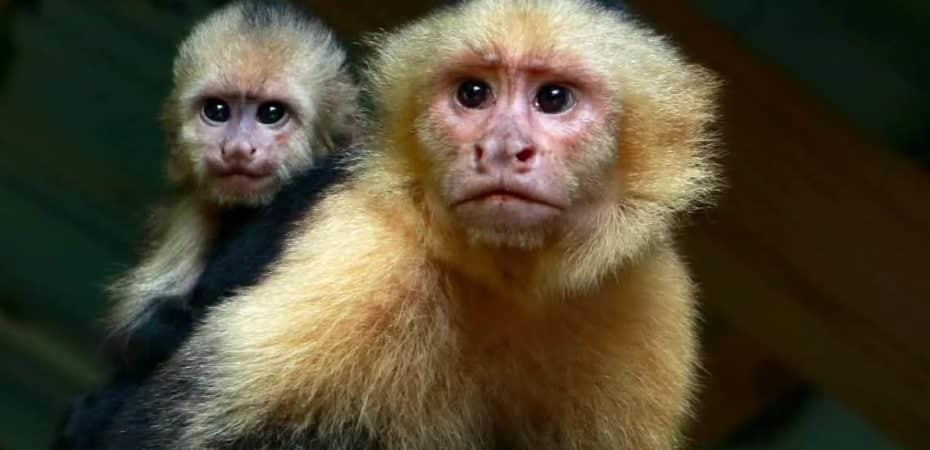Monkeys And Raccoons In Manuel Antonio National Park Have Been Found By Scientists To Suffer From Cavities, High Cholesterol, And Triglycerides
These diseases, very common in humans, have been identified in white-faced monkeys in Manuel Antonio National Park in the Central Pacific, although to a lesser extent in marmosets and howler monkeys. Monkeys were also found with dark teeth, dull fur, and bumps or spots on their bodies.
A study that began in 2012 by a team from the International Institute for Wildlife Conservation and Management (Icomvis-UNA) made these and other findings in Costa Rica's main national park (with an annual visitation of more than 478,000 people in 2023).
Laura Porras, an academic and researcher at Icomvis-UNA, explained to El Observador that the study also revealed that raccoons had stopped being primarily nocturnal and had adopted daytime schedules. And, unfortunately, some individuals also appeared to have high cholesterol.
But there's more: in a necropsy or autopsy performed on a monkey (which she witnessed), numerous parasites commonly found in the human body were found in the animal's stomach.
Among them were Plasmodium spp (the parasite that causes malaria), CHIKV (chikungunya virus), Mycoplasma spp, and Trypanosoma spp (which causes Chagas disease).
Diurnal RaccoonsPorras-who conducted the work with her colleague Grace Wong and Mauricio Jiménez, a veterinarian at the UNA-explained that the raccoons were studied in a small population, fitted with radio collars, and later used camera traps.
Thanks to these devices, it was determined that the raccoons changed their habits, at least during the period from 2012 until the pandemic. Obviously-the academic adds-it cannot be ruled out that this change began long before 2012.
During that period, findings were also made with white-faced monkeys-also known as capuchin monkeys or white-faced monkeys-which are the primates with the largest number of specimens in Costa Rica.
And the answer is...But why did the raccoons change their habits and the monkeys develop numerous human diseases? The answer is simple: humans gave them food, or they managed to acquire it. Even more serious: these are foods that are unsuitable for wild animals.
The researcher mentioned sandwiches, snacks, cookies, and even bananas. Although bananas are not part of their diet, people believe they should not eat them, as they can be harmful, Porras noted.
“At the health level, in several individuals, there was a positive correlation between the presence of infectious agents and changes in blood tests. Some of the changes may be due to the habitat and the likelihood of exposure to food of human origin, which translates into dietary imbalances and behavioral changes,” the specialist explained.
And what happened after the pandemic?The researcher emphasized that, although records aren't as robust as those compiled before the pandemic, it is known that the raccoons returned to being nocturnal.
The reason is simple: no humans gave them food or left food lying around. However, she has reported some sightings of raccoons present during the daytime upon the return of visitors to the park.
And the reality is the same with the monkeys: the white-faced monkeys continue to enjoy the food given to them by those who come to this protected area, despite the fact that feeding them is prohibited. Starting in October 2023, with the cage, this has been reduced to a minimum, Porras assured.
Fine for feedingIt is worth remembering that the Costa Rican Wildlife Conservation Law (Law No. 7317) prohibits feeding wild animals. This provision seeks to prevent damage to ecosystems and the species themselves.
This is because food provided by humans can alter natural behavior, affect their health, and create dependency. Feeding wildlife can also cause ecological imbalances and conflicts with humans, the law states.
Finally, the law provides for fines that can reach ¢140,000 for this violation. Porras indicated that among the efforts made to minimize and even eradicate the intentional or accidental feeding of monkeys or raccoons, a violation took place in 2023.
In October of that year, two closed metal structures (like cages) were placed: one around the soda and another next to a table area.“Tourists come in, close the door, eat there, all inside. Garbage management is done internally, and then they leave without food,” Porras emphasized. However, some tourists still manage to move food out of these cages.
However, more measures are needed. This one is insufficient, he says.“In addition to raising awareness among visitors to these sites about not feeding the animals, there should be more signage and even a Tourist Police presence. We need to educate more to raise greater awareness of the damage we are doing to wildlife,” Porras said.
This same awareness-he emphasized-should extend to lodging establishments, bars, and restaurants where monkeys like marmosets frequently come. The same applies to those who frequently visit the beaches and feed the animals.->RESONANCE – Shifting Reality For those who have experienced shifts in consciousness and know that more peace, joy, and love awaits in a better living environment. A bold shared vision. A living community and hub for innovation. A sustainable ecosystem for living and working. A model for the new future.
Legal Disclaimer:
MENAFN provides the
information “as is” without warranty of any kind. We do not accept
any responsibility or liability for the accuracy, content, images,
videos, licenses, completeness, legality, or reliability of the information
contained in this article. If you have any complaints or copyright
issues related to this article, kindly contact the provider above.
Most popular stories
Market Research

- United States Lubricants Market Growth Opportunities & Share Dynamics 20252033
- UK Digital Health Market To Reach USD 37.6 Billion By 2033
- Immigration Consultancy Business Plan 2025: What You Need To Get Started
- United States Animal Health Market Size, Industry Trends, Share, Growth And Report 2025-2033
- Latin America Mobile Payment Market To Hit USD 1,688.0 Billion By 2033
- United States Jewelry Market Forecast On Growth & Demand Drivers 20252033






















Comments
No comment